This post may contain affiliate links. See my disclosure policy.
Biryani is a mixed rice dish popular throughout the Indian subcontinent. It is made with long-grain basmati rice, meat, and aromatic spices including cinnamon, cloves, cumin, and saffron. Learn how to make this delicious chicken and lamb biryani recipe with my easy step-by-step instructions and images.
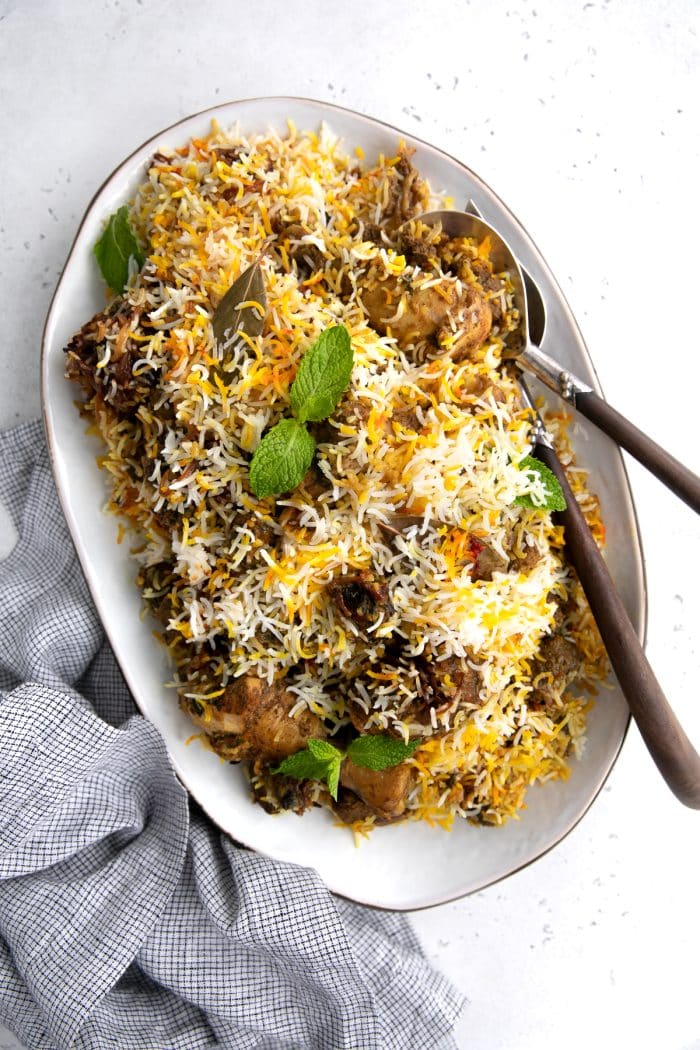
Lamb and Chicken Biryani Recipe
Quite labor-intensive, many home-cooks write off making their own biryani from scratch. I understand this completely, I mean there’s a lot going on here, like homemade spice blends, marinating meats, and par-cooked rice. I mean, what does that even mean, right?
Fortunately, I researched all of this and am here to tell you everything you need to know to make a fabulous biryani recipe right at home. Please read the entire post where I will walk you through each part step-by-step.
Let’s get started.
What is Biryani?
One of the most popular and well-known of all Indian dishes, biryani is a heavily spiced mixed rice dish. There are many different versions of biryani. Key among them all are key ingredients including long-grain basmati rice, exotic spices (who else loves saffron?), vegetables, and often, different meats including chicken, lamb, beef, goat, or fish.
It is, in a sense, a pot filled with your favorite meat or vegetable curry topped with soft and fluffy cooked rice. The bonus of this rice, however, is that it steams over low heat atop all that deliciously spiced, marinated meat, absorbing all the wonderful flavors and spices.
Biryani gets its name from the Persian word birian, which means “fried before cooking”. How biryani came to be, however, is of much debate, but most agree that it originated in Persia, and later brought to India by the Mughals.
Ingredients and Frequently Asked Questions
For the full list and amounts of ingredients, please scroll down to the recipe card at the bottom of the page.
- Onions
- Oil
- Cinnamon sticks
- Whole green cardamom
- Whole cloves
- Bay leaves
- Black cumin seeds (shah jeera)
- Black pepper
- Salt
- Chicken and Lamb
- Fresh ginger
- Fresh garlic
- Chili powder (not cayenne)
- Ground turmeric
- Serrano or Jalapeño peppers
- Yogurt
- Long-grain rice
- Cilantro
- Mint
- Lemon
- Saffron
- Ghee or Butter
- Nuts or Dried fruit (not shown)
Yes, I know. The ingredient list is quite long. If you have an Indian market (or Middle-Eastern grocery store) near where you live, you will be able to find most of the more uncommon ingredients there. Everything else? The internet is your friend!
Do I have to add lamb? What if I just want to add chicken?
You want approximately 6 pounds of meat for this recipe. This can come in the form of chicken, lamb, goat, beef, or even pork. Traditionally, biryani would have been made using goat or mutton, but chicken is a popular substitute. Lamb is my personal favorite.
While we’re on the subject of chicken, let me mention two things:
- Chicken breasts are not recommended. They’re lean and likely to dry out.
- Drumsticks are wonderful and affordable, but bone-in skin-on chicken thighs (with some of the excess skin removed) is just as great.
What is the best rice for biryani?
If you can find basmati rice, then this is the rice you want to use. Naturally aromatic, it is the most commonly used rice throughout India and really works beautifully with biryani. Any other long-grain rice will work, but the results won’t be nearly as fluffy and delicious as basmati.
Can I use brown basmati rice?
Yes. With a couple of modifications.
- When par-cooking brown basmati rice, add an additional 2-3 tablespoons of water.
- Soak the rice – both the rice used for par-cooking and the raw rice (don’t worry if this makes zero sense, it is all explained in the instructions).
RELATED: How to Cook Brown Rice
Can I use store-bought fried onions?
Store-bought fried onions or shallots are a fantastic way to save on time. You can find them at most Asian or Indian supermarkets. I do not recommend French’s fried onions.
Can I make this biryani vegetarian?
While I have not tried this recipe without meat, here’s how I would do it –
- Prepare the marinade and homemade marinade spice mix as instructed.
- Gather approximately 8-10 cups of my favorite vegetables (carrots, cauliflower, potato, onions, peas, etc).
- Saute the carrots, onions, and potato for approximately 5-10 minutes in a 1-2 tablespoon vegetable oil over medium-high heat, or until they just start to soften.
- Mix in the cauliflower and peas, if using.
- Remove from heat and combine with the prepared marinade.
- Continue the recipe as outlined.
What is dum style?
This is actually a method of cooking and one which we use to make this recipe. It requires a tight seal between the pot and the lid (for steaming) which was traditionally achieved using wheat flour dough wrapped around the pot. In our case, we’re using 1-2 sheets of aluminum foil set between the pot and the lid.
How do I know if I made a good biryani?
Well, first and foremost, it should taste good. Other things to look at are the rice and the meat. My mother-in-law always told me she knew her basmati rice was made well when, if she picked up a handful and threw it on a plate (or the wall), it would scatter into individual grains rather than clump together or stick to the surface of the wall. The meat should be fully cooked, tender, and moist. Bone-in meat is best.
How to Make Biryani
Before getting started, make sure you have the following tools and equipment:
- Large, heavy-bottomed pot or Dutch Oven
- Large pan or pot with high sides for frying the onions
- Pot or pan with a tight-fitting lid to par-cook the rice
- Slotted spoon
- Fine-mesh strainer
- Spice grinder or coffee grinder
- Blender or food processor
Step 1 – Fry Onions
After slicing several onions nice and thin, get them ready to be fried. To do this, simply heat oil (sunflower oil or peanut oil) in a large, wide frying pan with high sides over medium-high heat. You will know the oil is hot when you can feel the radiating heat on the palm of your hand when you hover your hand 2-3 inches above the oil.
Add the sliced onions in a single layer (avoid overcrowding) and fry until golden brown. Remove using a slotted spoon to a plate lined with paper towels and repeat until all onions have been fried. Set the onions aside.
Strain any leftover oil into a small jar or container save for later use.
Step 2 – Grind the Whole Spices (Needed for the Marinade)
In this step, you’re going to need that spice grinder because we’re going to be making our very own spice mix that will be used in the next step.
The spices you will be using and adding to your grinder include:
- 1 Cinnamon stick
- 5 Whole green cardamom pods
- 6 Whole cloves
- 1 Bay leaf
- 1 teaspoon Black cumin seeds (not the same as regular cumin seeds)
- 1/2 teaspoon Black pepper
Grind until evenly ground.
Note: If you’re familiar with star anise, add 1 whole star anise pod to your grinder. Sadly, I forgot.
Step 3 – Mix and Marinate the Chicken and Lamb
Now we’re going to grab a large bowl. Add the plain full-fat yogurt, minced up garlic paste, grated ginger, seeded and diced green chili, ground turmeric, chili powder, and at least 1 teaspoon salt. Mix well to combine.
- Tip – You may be tempted to add extra yogurt (or perhaps this is just me), but hold off. We need enough yogurt to fully bathe the chicken and lamb in the delicious marinade, but not so much that it’s swimming in it.
Add the spice mix (step 2, see above) and mix it in with the yogurt marinade.
Now, add the chicken and lamb. Really use your hands to thoroughly cover every inch of meat. Grab a small handful of your fried onions (step 1, see above) and mix those in there too.
Cover with plastic wrap and transfer to the refrigerator. Marinate for at least 2-3 hours.
Step 4 – Par-Cooked Rice and Rice Preparation
This step is all about the rice. Plan to start this step approximately 90 minutes before you plan to serve your biryani.
To begin, measure out 2.5 cups of dry basmati rice. Next, (before washing and soaking) divide into one 2 cup portion and one 1/2 cup portion. Or, put another way, place 2 cups of basmati rice in one bowl, and 1/2 cup of basmati rice in another bowl.
The first batch (the one with 2 cups of measured rice) will be par-cooked. Par-cooking simply means to cook something part of the way. The second batch (the bowl with half a cup of basmati rice) will be soaked and added to the pot raw (so neither cooked nor par-cooked).
Now that we have that covered, let’s take the bowl with half a cup of rice and cover with approximately 2-3 cups of cold water. Set aside to soak for at least 30 minutes.
The other bowl containing two cups of basmati rice needs to be washed. For best results, wash in several changes of cold water, or until the water runs nearly clear. Drain well.
Now we’re ready to par-cook the 2 cups of washed rice,
- Bring 2½ cups water to a boil in a medium saucepan over medium-high heat with 1 teaspoon of salt, 2 tablespoons of oil, 3 whole green cardamom, 4 whole cloves, 2 bay leaves, and half of a cinnamon stick.
- Once boiling, immediately add the rinsed rice. Stir and reduce heat to low.
- Cook until all the water is absorbed – this will only take approximately 5 minutes.
- Do not cover and steam the rice. We are only cooking the rice about halfway.
- Immediately remove from heat and gently fluff with a fork. Transfer to a new, larger pan or (as I like to do) transfer to a large, rimmed baking sheet lined with parchment paper (this helps prevent the rice from steaming and sticking together). Set aside.
Step 5 – Layer and Cook the Biryani
After the rice has been par-cooked, we have everything ready and in place to start assembling the layers for the biryani in our pot.
- Layer 1: Remove the chicken pieces and lamb from the refrigerator. Transfer the chicken and lamb (plus the marinade and spices it’s been bathing in) to a heavy-bottomed, oven-safe, Dutch Oven or large pot (at least 5-7 quarts).
- Layer 2: Sprinkle the chopped cilantro and fresh mint over the chicken and lamb. Top with half (or all) of the remaining fried onions and drizzle with fresh lemon juice.
- Layer 3: Drain and rinse the 1/2 cup of soaking basmati rice from step 4 (see above) and sprinkle it over the onion layer. This rice is not cooked and that’s ok. It will cook and absorb the steam/moisture from the cooking lamb and chicken, preventing it from making the par-cooked rice too soggy.
- If you love rice dishes with dried fruit like raisins or dried cranberries, add them here, just after the raw rice. Approximately 1 cup will suffice.
- Layer 4: Spread the par-cooked basmati rice over the top of the uncooked white rice (I highly recommend removing the whole cloves and whole green cardamom before adding). Drizzle with prepared saffron water (just 1 teaspoon of saffron threads mixed in 2-3 tablespoons of warm water) and 1-2 tablespoons of melted ghee or butter (optional).
All that’s left is to cook your chicken and lamb biryani for approximately an hour.
To prevent any steam from escaping, place 1-2 sheets of aluminum foil over your pot or Dutch oven. Place the lid directly on top (I love using a heavy Dutch oven for this because the lid is so heavy and sits snug directly right on top of the foil).
Transfer the pot to a 375-degree oven and cook for approximately 45-60 minutes (total cooking time will vary depending on the size and cut of meat used).
Remove from the oven and allow it to cool for 5-10 minutes before gently mixing the rice and chicken. Serve directly from the pot or transfer to a large serving plate with additional cilantro or mint. Serve with creamy raita, crisp cucumbers, and fresh naan.
More Indian Recipes,
Kheer Recipe (Indian Rice Pudding)
Butter Chicken Recipe (Murgh Makhani)
Vegetarian Cauliflower Tikka Masala Recipe (Instant Pot)
If you try making this Chicken and Lamb Biryani Recipe, please leave me a comment and let me know! I always love to hear your thoughts.

Biryani Recipe
Ingredients
Fried Onions
- 3 medium yellow onions, peeled and thinly sliced
- 1½ cups oil, (sunflower oil or peanut oil)
Biryani Spices (used in the marinade)
- 1 whole cinnamon stick
- 5 whole green cardamom
- 6 whole cloves
- 1 bay leaf
- 1 teaspoon black cumin seeds, (shah jeera)
- ½ teaspoon ground black pepper
Chicken and Lamb + Marinade
- 5 chicken drumsticks, or chicken thighs
- 2½ lbs lamb shoulder , boneless or bone-in, chopped into large chunks (you may also use lamb chops or leg of lamb)
- 1 tablespoon fresh ginger, minced
- 6 cloves garlic, minced
- 1 teaspoon salt
- 1.5 teaspoon mild chili powder
- 1.5 teaspoon ground turmeric
- 2 Serrano peppers, seeded and diced
- 1 cup plain full-fat yogurt
Par-Cooked Rice + Rice Preparation
- 2½ cups long-grain white basmati rice, divided
- 1 teaspoon salt
- 2 tablespoon olive oil
- 3 whole green cardamom
- 4 whole cloves
- 2 bay leaves
- ½ cinnamon stick
Biryani
- ½ cup cilantro, chopped
- ¼ cup fresh mint leaves, chopped
- 1 lemon, juiced
- 1 teaspoon good-quality saffron, soaked in 3 tbsp of hot water or warm milk
- 4 tablespoon melted butter or ghee, (optional)
Instructions
Fried Onions
- Let's start by frying some onions. For best results, try to slice your onions super thin. This will help them get nice and crispy and will also help them cook faster - two things we want when we're frying onions.
- To fry, heat the oil (sunflower oil or peanut oil) in a large, wide frying pan with high sides over medium-high heat. When the oil is hot (you should feel the heat on your hand when you hover your palm 2-3 inches above the oil), add the sliced onions in a single layer (avoid overcrowding). Fry until golden, light brown, and crispy. Remove using a slotted spoon to a plate lined with paper towels and repeat until all onions have been fried. Set onions aside and strain leftover oil for use in later recipes.
Biryani Spices (needed for the marinade)
- Transfer the cinnamon stick, whole green cardamom, whole cloves, bay leaves, black cumin, and black pepper to a nut or spice grinder. Grind completely. Set aside.
Chicken and Lamb + Marinade
- Combine the minced ginger, garlic, salt, mild chili powder, ground turmeric, diced Serrano peppers, and full-fat yogurt in a large mixing bowl. Add the ground biryani spices (from the previous step above) and mix well to combine.
- Add the chicken drumsticks and lamb pieces to the marinade. Use your hands to thoroughly mix and coat the entire surface of the chicken and lamb.
- Add approximately 1/3 of the fried onions and mix again. Cover with plastic wrap and transfer to the refrigerator. Marinate for at least 2-3 hours.
Par-Cooked Rice + Rice Preparation
- Approximately 90 minutes before you plan to serve your biryani, start the rice.
- Divide the rice before washing/soaking. Place 1/2 cup of rice in a medium bowl and cover with approximately 3 cups of cold water. Set aside to soak for at least 30 minutes. Thoroughly wash the remaining 2 cups basmati rice in several changes of cold water, or until the water runs nearly clear. Drain well.
- Bring 2½ cups water to a boil in a medium saucepan over medium-high heat. Add 1 teaspoon of salt, 2 tablespoons of oil, and whole spices (green cardamom, cloves, bay leaves, cinnamon stick). Once boiling, immediately add the rinsed rice. Stir and reduce heat to low.
- Cook until all the water is absorbed - this will only take approximately 5-10 minutes. Do not cover and steam the rice. We are only cooking the rice about halfway.
- Immediately remove from heat and gently fluff with a fork. Transfer to a new, larger pan or (as I like to do) transfer to a large, rimmed baking sheet lined with parchment paper. Set aside.
Assemble the Biryani
- Layer 1: Remove the marinating chicken pieces and lamb from the refrigerator. Transfer the chicken and lamb (plus the marinade and spices its been bathing in) to a heavy-bottomed, oven-safe, Dutch Oven or large pot (at least 5-7 quarts).
- Layer 2: Sprinkle the chopped cilantro and fresh mint over the chicken and lamb. Top with half (or all) of the remaining fried onions and drizzle with fresh lemon juice.
- Layer 3: Drain and rinse the remaining 1/2 cup of soaking basmati rice. Spread over the onion layer. This uncooked rice will help absorb much of the steam/moisture from the cooking lamb and chicken, preventing it from making the par-cooked rice too soggy.
- Layer 4: Spread the par-cooked basmati rice over the top of the uncooked white rice (I highly recommend removing the whole cloves and whole green cardamom before adding to the pot). Drizzle with the prepared saffron water and 1-2 tablespoons of melted ghee or butter, if desired.
- Preheat oven to 350°F.
- To prevent any steam from escaping, place 1-2 sheets of aluminum foil over your cooking pot or Dutch oven. Place the lid directly on top (I love using a heavy Dutch oven for this because the lid is so heavy and sits snug directly right on top of the foil).
- Transfer pot to the oven and cook for approximately 45-60 minutes (total cooking time will vary depending on the size and cut of meat used).
- Remove from the oven and allow it to cool for 5-10 minutes before gently mixing the rice and chicken. Serve directly from the pot or transfer to a large serving plate with additional cilantro or mint. Serve with creamy yogurt, crisp cucumbers, and fresh naan.
Notes
Nutrition
Nutrition information is automatically calculated, so should only be used as an approximation.
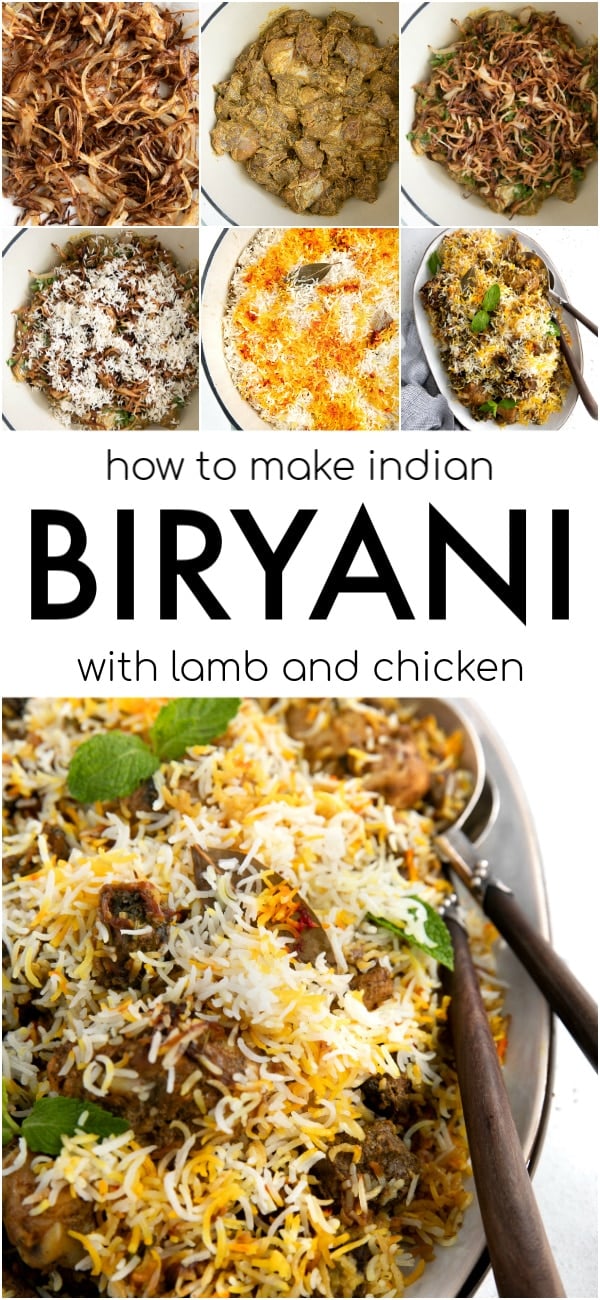
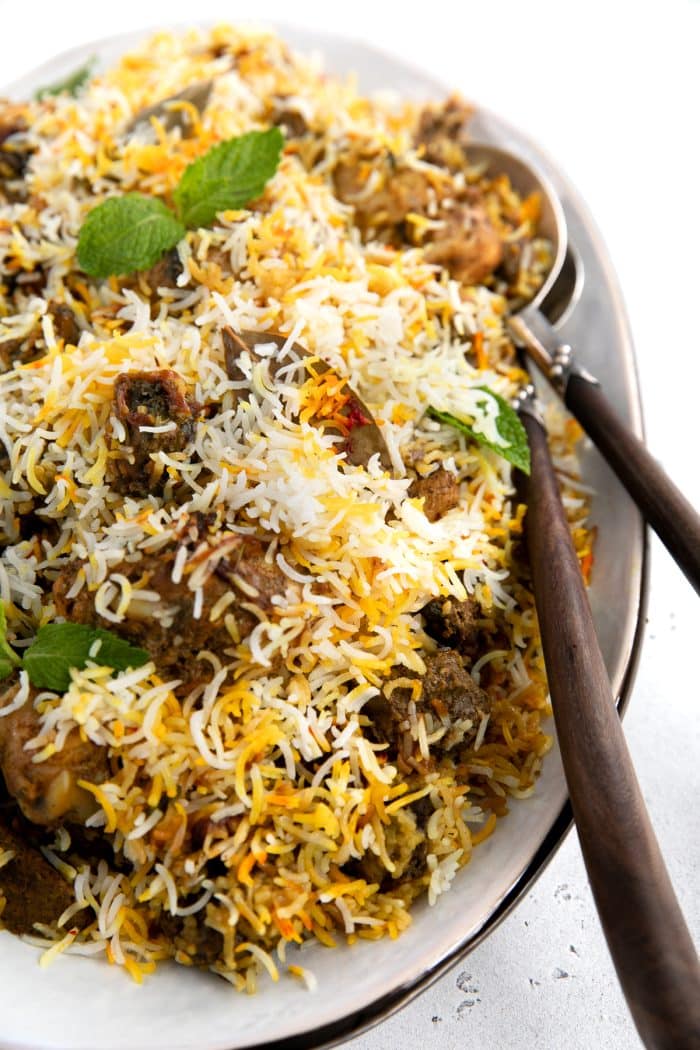
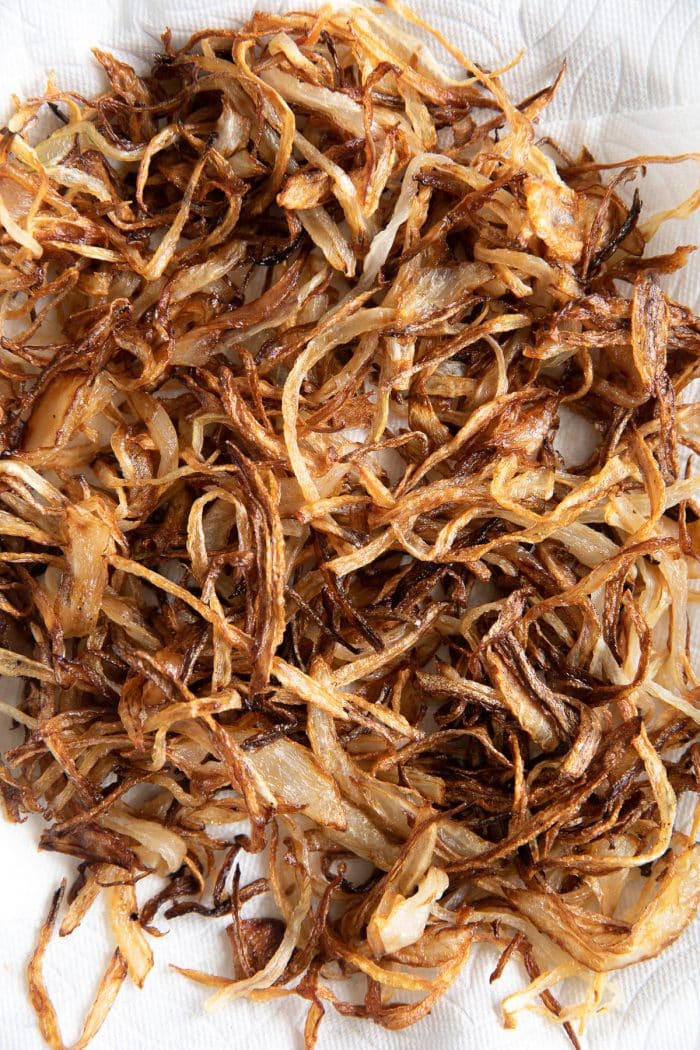
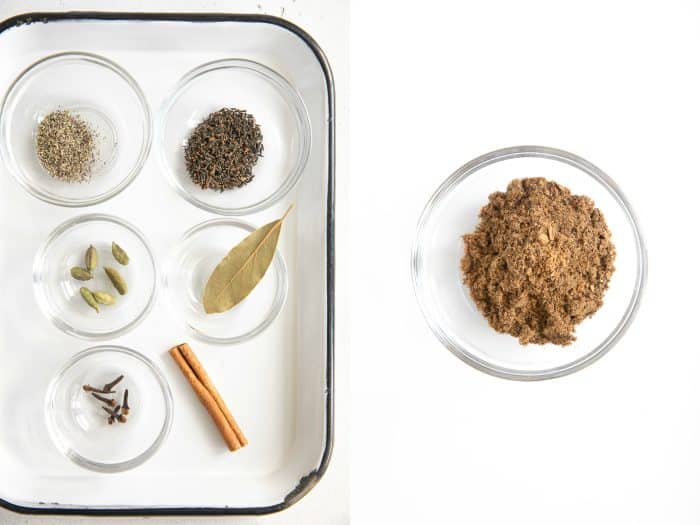
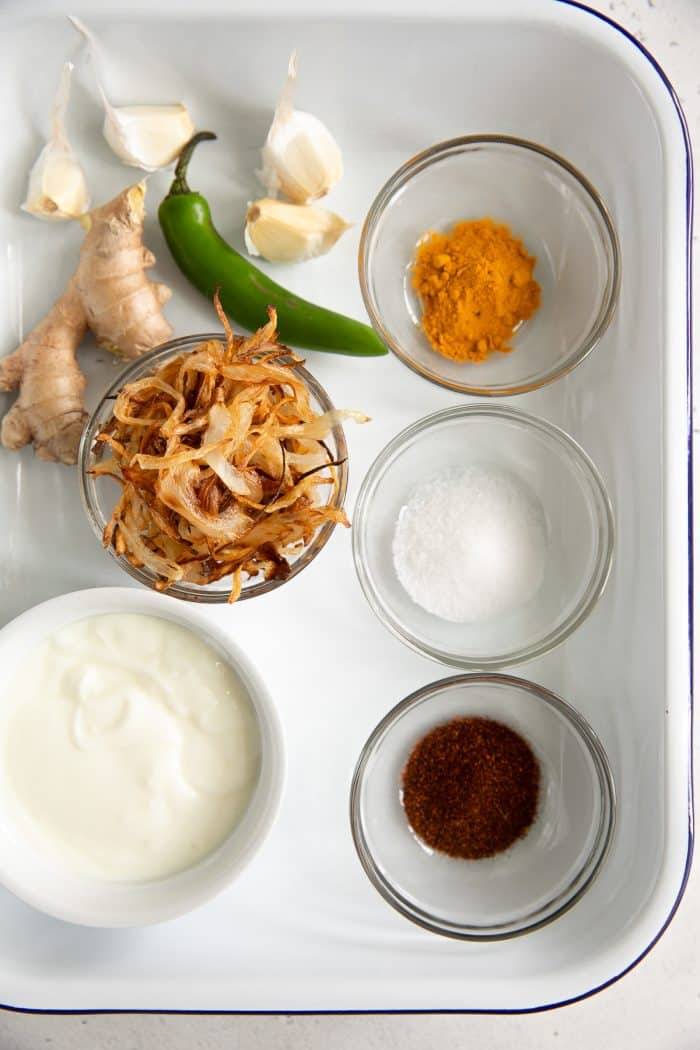
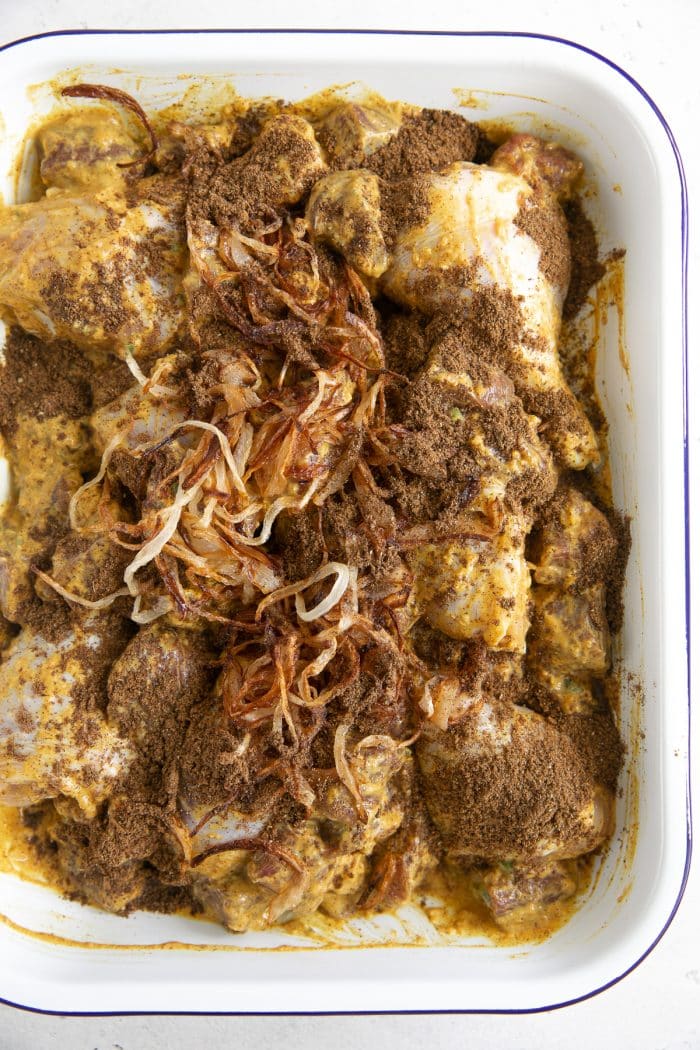
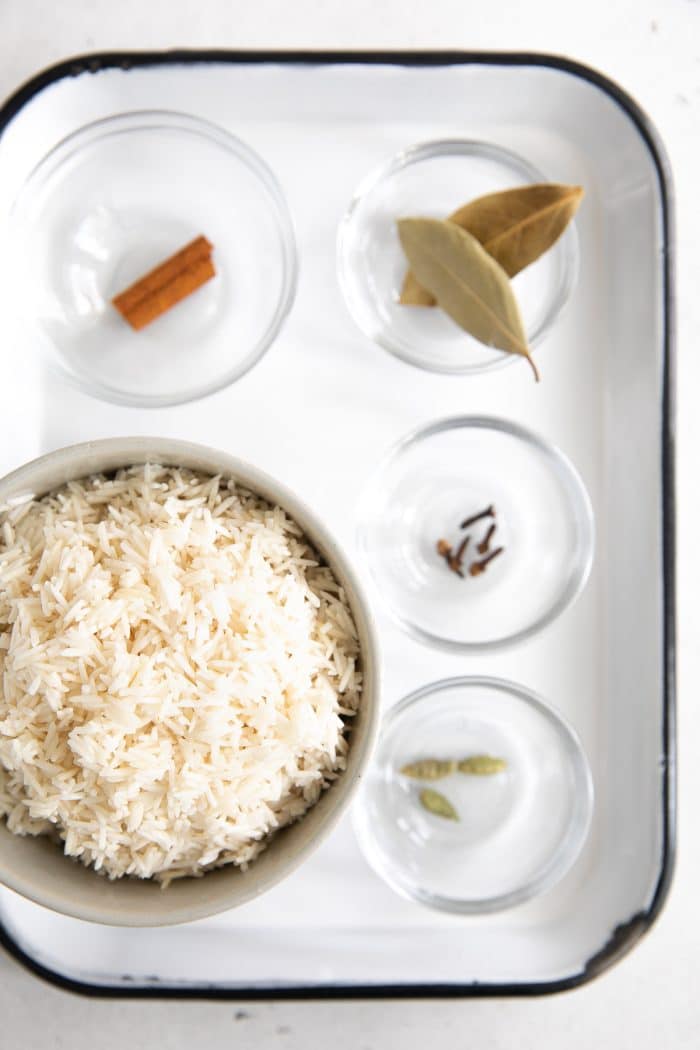
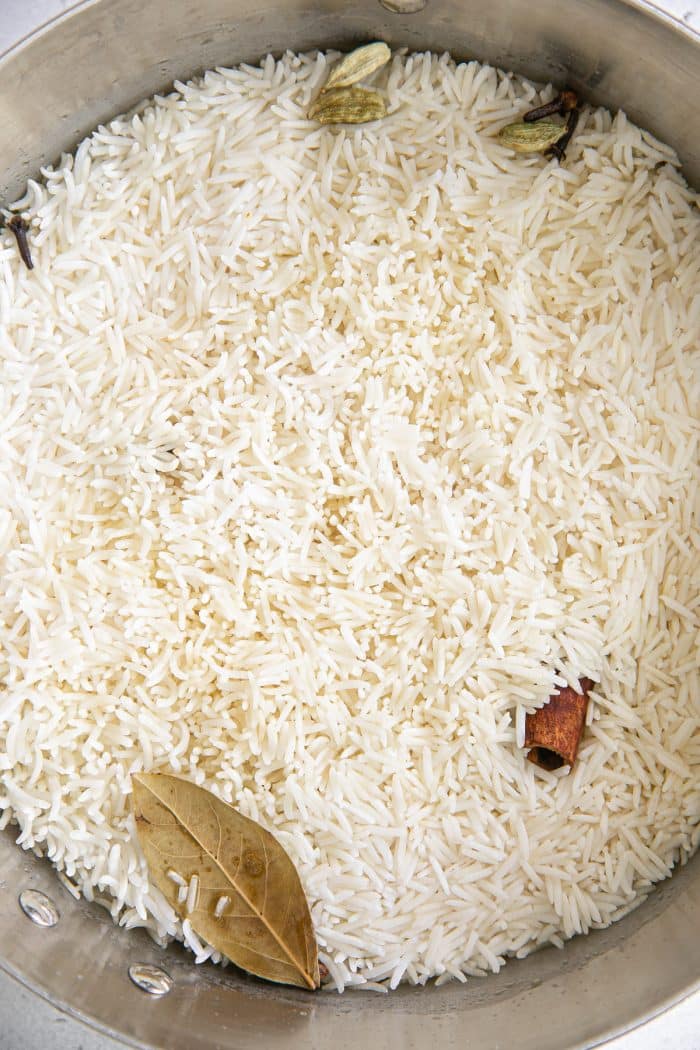
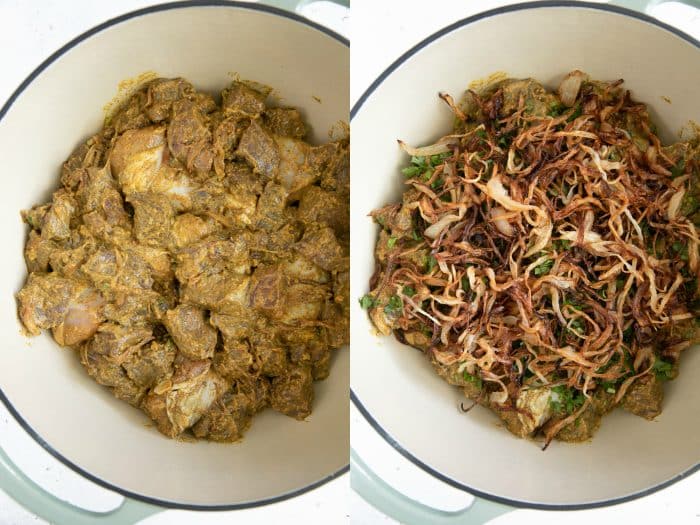
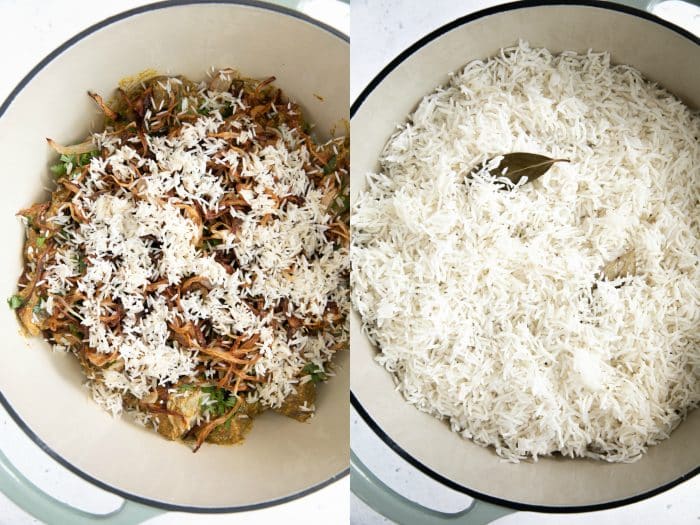
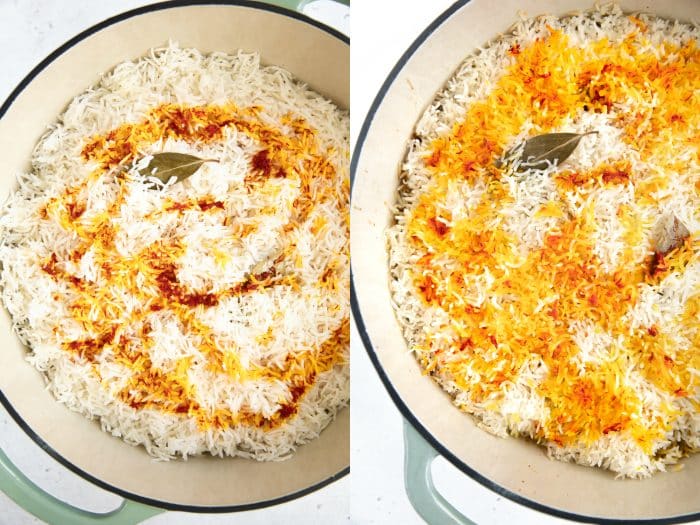
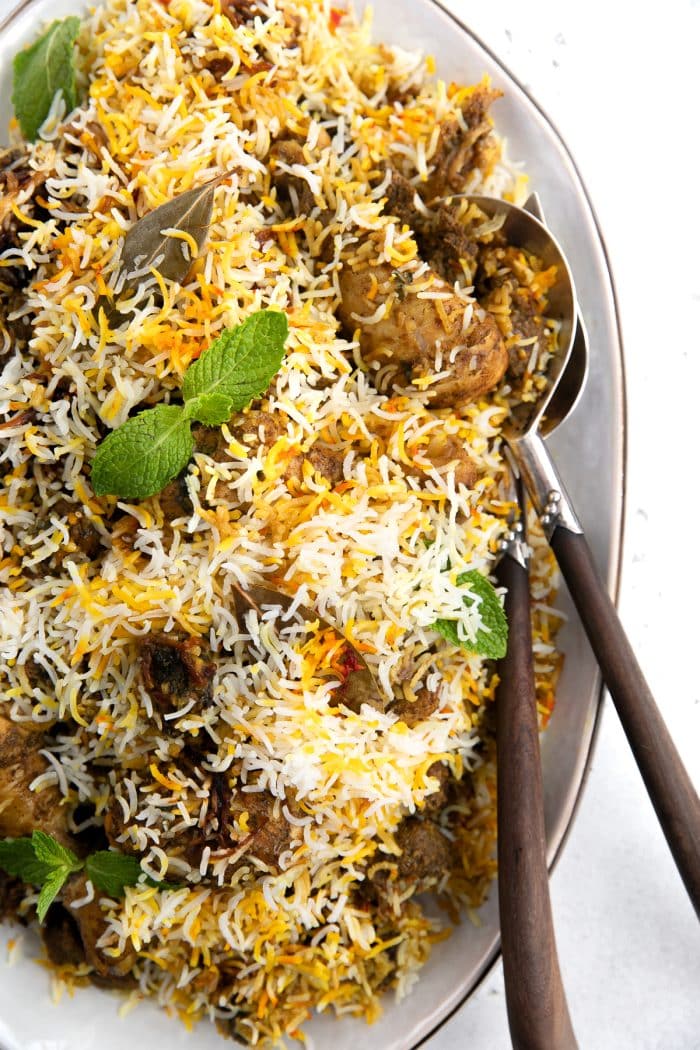
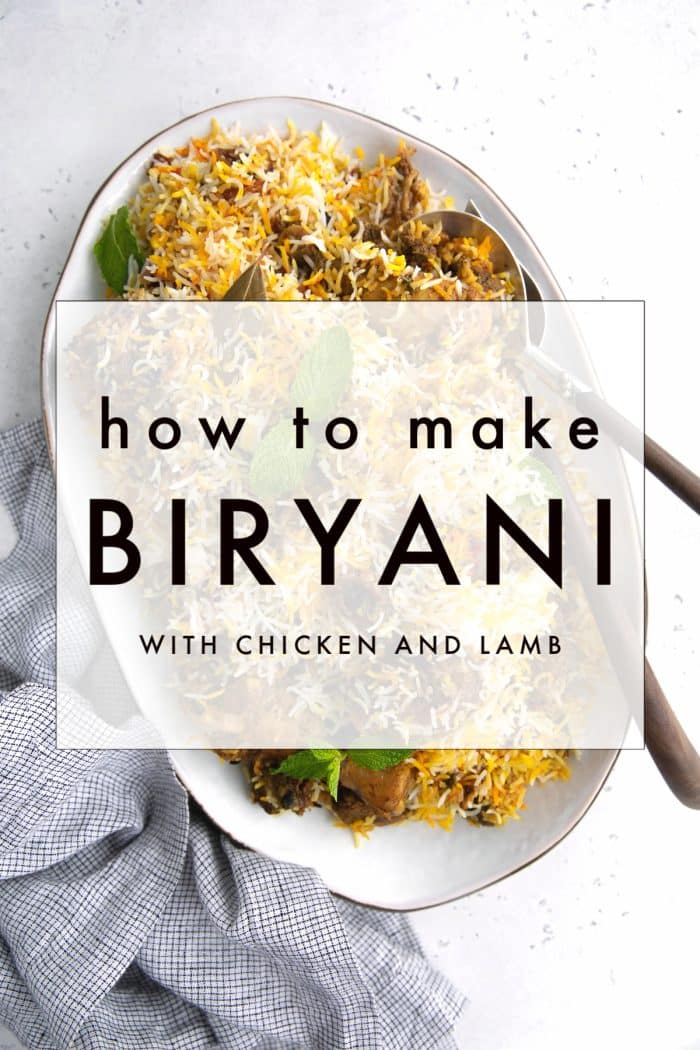
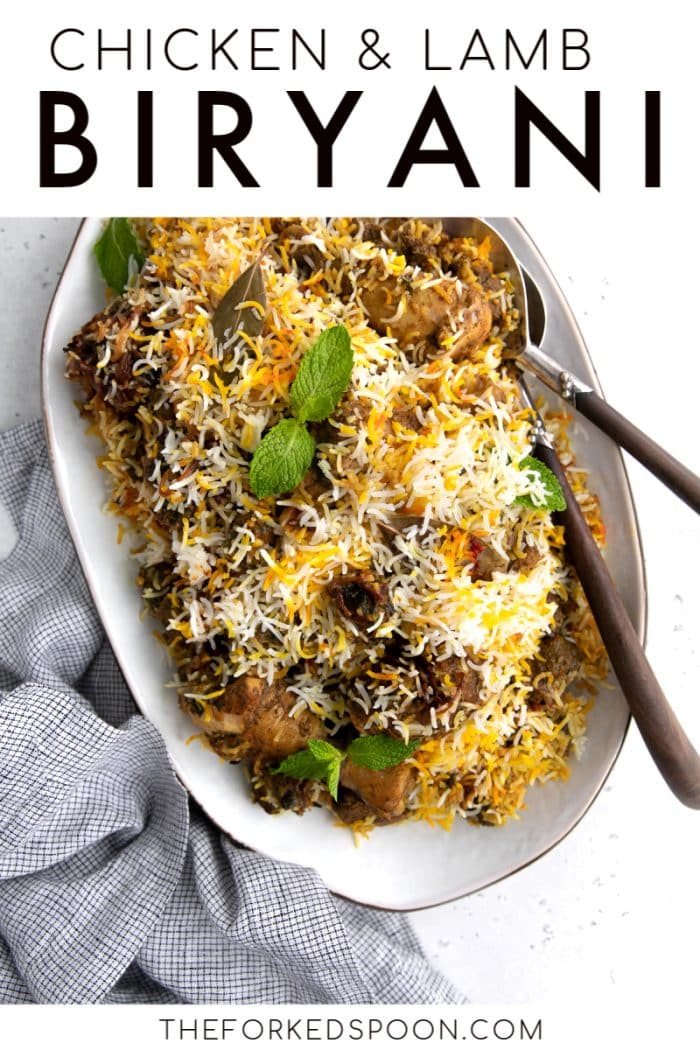



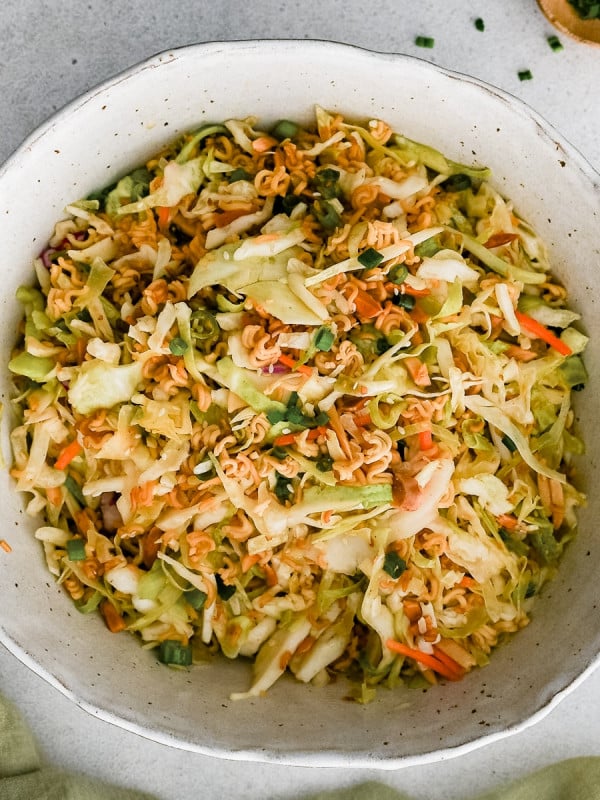









The biryani no doubt look amazing.
Thanks for sharing it.
Not sure why my dish is taking so long to cook. It’s been in the oven for about an hour and 45 minutes. I used bone in chicken thighs and added butternut squash and mushrooms to the pot. Not sure how big my pot is but it’s pretty full. I filled it maybe about two inches from the rim. I wasn’t exactly sure if I should buy bone in or boneless chicken (lamb is hard to find in my area). Maybe some clarity on what cut of meat to use? It does smell good though so I’m looking forward to trying it once it’s cooked!
Those additions of butternut squash and mushrooms both have water in them that drops when cooking, which is probably adding to the cooking time.
This is easily my new favorite rice dish!
Absolutely amazing and delicious aromas from making the briyani
Especially following each step with patience
The new was using the raw rice
This is a keep safe recipe
Recipe was a great success. However cooking in oven did not work so I simmered on stove top. Also added sultana’s , carrot, marrows, mushrooms & butternut. Skipped the saffron, too expensive for too little gain. Basmati rice was not available so I used plain white rice. Will definitely be doing again.
Thanks for the kind feedback John, I am glad it was a success 🙂